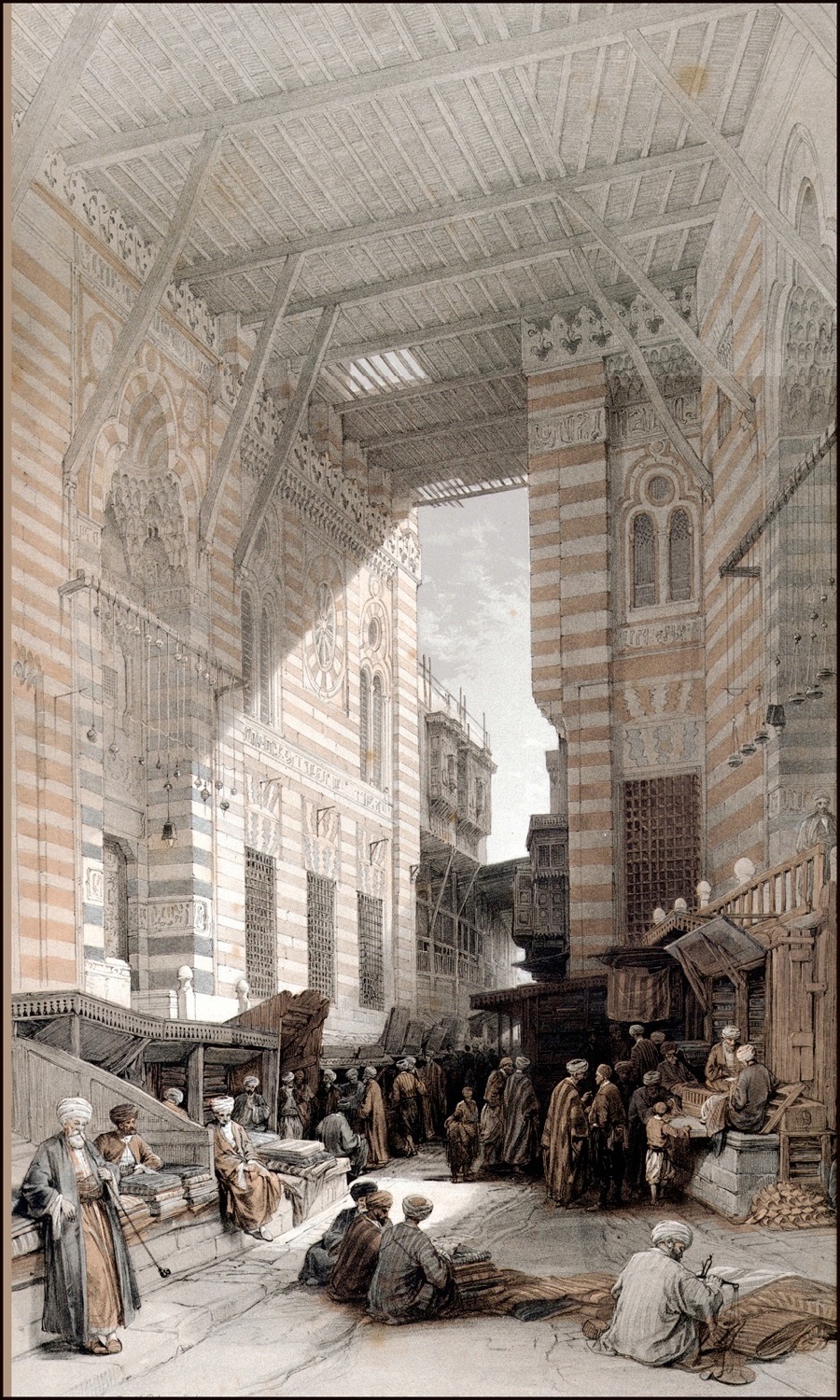THE SILK-MERCERS' BAZAAR OF EL GHOOREEYEH, CAIRO
THIS Bazaar is so called from the mosque and tomb of the Sultan El-Ghoree, which are situated on either side of the Bazaar. On the left the porch appears, which leads to the collegiate mosque; and on the right, that by which the sepulchral mosque is entered, flight of steps lead to each; and the porches are very handsome: they are usually the most enriched parts of these edifices below the minarets. Sometimes coloured marbles are profusely used, here they are black and white, and display rich and intricate arabesques, and inscriptions from the Koran in Khufic characters, and the walls are agreeable coloured with horizontal stripes of red and white: nightly burning lamps are suspended over the entrances of these portals, which serve as places of refuge for the destitute, and hundreds of houseless wretched sleep beneath them.
These mosques of the Sultan El-Ghoree were completed A.D. 1503, and are examples of the latest of the religious monuments of the Sultans of Egypt, as the mosque of Tooloon is of the earliest; for the successor of El-Ghoree, Tómán Bey, who was hung by order of the Sultan Selim, closed the dynasty.
The actual situation of this Bazaar is between the walls of these two mosques, which finish at the top with a trefoil sort of battlement whereon rafters rest, with props to support the wooden roof, that at a great height covers the Bazaar, admitting light enough, but sheltering it from the rays of the sun. Each Bazaar is generally appropriated to a particular class of merchandise, and this, the chief in Cairo, for the sale of rich silks, cottons, and embroidered stuffs, some wrought in gold-thread and other costly materials; and the articles to be bought here are the most splendid productions of this class. The Bazaars of Cairo, as in al Eastern cities, are confined to streets and passages, which are closed at night with wooden doors and a chain, and guarded by watchmen: they are, however, by day the gayest and most amusing parts of the city. Here the shopkeeper rests on a sort of dais, or shopboard, about three feet above the footway, his goods being kept in recesses behind him. He generally sits cross-legged and patient, awaiting the arrival of a customer; he uses little art to induce him to purchase; he sits in solemn silence, and will scarcely remove his pipe from his lips to answer the inquiries of the passers-by; but a Frank, and especially an Englishman, if habited in Eastern costume, of whom he can and does ask more than four times the value of an article, will often excite him to acts of courteous attention, and a pipe and coffee are presented during the negotiation. On certain days, a peripatetic set of auctioneers, called delláls, strikingly contrast their animation with the apathetic dealers, for they force their way amidst the crowd, showing their articles on sale, screaming in their praise, and shouting the amount of the biddings.
Mr. Roberts says that there were few situations in Cairo in which he was so much struck with the picturesque appearance of the population as in the Bazaars, and this long after the mere novelty of their costume had passed away. These Bazaars are, of all places, the most extraordinary to an European; each is characterised by its merchandise or its handicraft; and groups are seen at the stalls cheapening articles, and heard screaming at a pitch of voice like a quarrel.
Wilkinson's Egypt.
Robert's Journal.


